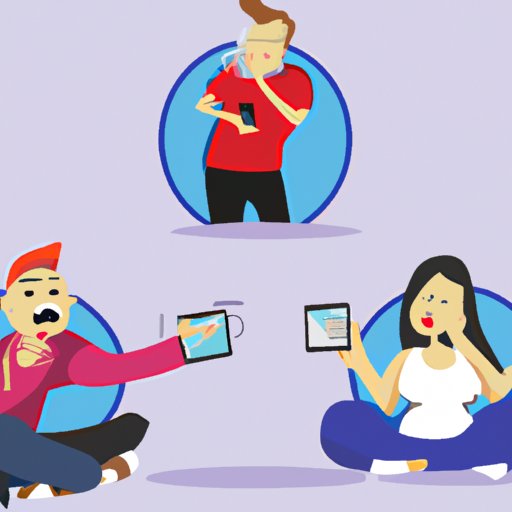Introduction
Generation Z, also known as “Gen Z” or “Zoomers,” refers to those born between 1996 and 2010. This generation has grown up in a world where technology and digital media are ubiquitous, and their lives have been profoundly shaped by advances in technology. In this article, we will explore how technology is affecting the younger generation, with particular focus on Generation Z.

Examining the Impact of Technology on Generation Z
Technology has had a major impact on the lives of young people today, from how they communicate with each other to how they learn in school. Let’s take a closer look at how technology is changing education, social media use, and mental health for Gen Z.
How Technology Is Changing Education
Technology has drastically changed the way that young people learn. According to a study conducted by the Pew Research Center, almost all teens (95%) report going online daily, and 74% of teens say they go online “several times a day.” These numbers suggest that technology is playing an increasingly important role in how young people access information and learn new skills. For example, many students now use laptops, tablets, and smartphones to research topics, complete assignments, and collaborate with peers.
In addition, technology has allowed teachers to use innovative teaching methods and tools to engage students and make learning more interactive. For instance, teachers can now use virtual reality (VR) headsets to bring lessons to life and create immersive learning experiences. Moreover, technology has enabled teachers to personalize learning and tailor instruction to meet the needs of individual students.
The Pros and Cons of Social Media Use
Social media has become an integral part of the lives of many young people. A survey conducted by Common Sense Media found that 75% of teenagers have a profile on at least one social networking site, and 59% of teens check their accounts multiple times a day. While there are some potential benefits to using social media, such as connecting with friends and family, it can also have negative impacts on mental health and wellbeing.
Research suggests that heavy social media use can lead to feelings of isolation, depression, and anxiety. Additionally, it can create a false sense of connectedness and lead to comparison, which can be damaging to self-esteem. On the other hand, research has also found that social media can be beneficial in some cases, such as helping young people build relationships and find support networks.
Understanding the Relationship Between Technology and Mental Health
As technology continues to pervade our lives, it’s important to understand its effects on mental health. Research suggests that technology can both positively and negatively impact mental health, depending on how it is used. For example, some studies have found that spending time online can help reduce feelings of loneliness and improve self-esteem. On the other hand, too much time spent on screens can lead to sleep deprivation, which can have a negative effect on mental health.
It’s also important to recognize that technology can be both a cause and a consequence of mental health issues. For instance, while some people may use technology to cope with mental health issues, others may develop mental health issues due to excessive technology use. As such, it’s important to understand the relationship between technology and mental health and to be aware of the potential risks of overusing technology.

How Young People Are Being Affected by Technology Addiction
Technology addiction is a growing problem among young people, particularly those in Generation Z. Technology addiction is defined as an unhealthy obsession with technology and can lead to a range of physical, psychological, and social problems. Signs of technology addiction include feeling anxious when not using technology, neglecting other activities to spend more time online, and experiencing withdrawal symptoms when trying to cut back on technology use.
Fortunately, there are strategies that can help reduce technology addiction and its associated risks. For instance, parents can set limits on screen time and encourage their children to engage in other activities. Additionally, young people can try to limit their use of devices in certain contexts, such as during meals and before bed. Finally, it’s important to recognize that technology addiction is a serious issue and seek professional help if needed.

Exploring the Benefits and Drawbacks of Technology for Youth
Technology can be both beneficial and detrimental for young people, depending on how it is used. On the one hand, technology can provide access to vast amounts of information and enable young people to connect with others around the world. Additionally, technology can help foster creativity and collaboration, as well as provide opportunities for learning and exploration. On the other hand, technology can be distracting and can lead to feelings of isolation and depression.
It’s important to recognize the potential benefits and drawbacks of technology for young people and strike a balance between using technology and engaging in offline activities. For instance, it’s important to encourage young people to take breaks from screens and spend time outdoors or engaging in other activities. Additionally, parents should set rules and limits around technology use and be mindful of how technology is impacting their child’s development.
Understanding the Relationship Between Technology and Mental Health in Children and Teens
The increased use of technology by young people has raised concerns about its potential impact on mental health. Studies have found that too much time spent on screens can lead to sleep deprivation, which can have a negative effect on mental health. Additionally, research suggests that heavy social media use can lead to feelings of isolation, depression, and anxiety.
It’s important to be aware of the potential risks of technology use and take steps to reduce its impact on mental health. For instance, parents can set limits on screen time and encourage young people to engage in other activities. Additionally, it’s important to monitor technology use and be aware of any signs of technology addiction. Finally, it’s important to recognize that technology use can be both a cause and a consequence of mental health issues, and seek professional help if needed.
Examining the Pros and Cons of Social Media Use Among Young People
Social media has become an integral part of the lives of many young people, but there are both advantages and disadvantages to its use. On the one hand, social media can be beneficial in some cases, such as helping young people build relationships and find support networks. On the other hand, it can also have negative impacts on mental health and wellbeing, such as creating a false sense of connectedness and leading to comparison.
It’s important to recognize the potential benefits and drawbacks of social media use and take steps to ensure it is used responsibly. For instance, parents should talk to their children about the potential risks of social media use and encourage them to be mindful of how much time they spend online. Additionally, young people should be aware of the signs of social media addiction and take steps to reduce their use of social media if needed.

Looking at How Technology Is Changing Education for Young People
Technology has drastically changed the way that young people learn, from how they access information to how they collaborate with peers. For example, technology has enabled teachers to use innovative teaching methods and tools to engage students and make learning more interactive. Additionally, technology has allowed for personalized learning, enabling teachers to tailor instruction to meet the needs of individual students.
However, there are also some challenges associated with technology in education. For instance, there can be a digital divide if not all students have access to the same resources. Additionally, there is a risk that students may become overly reliant on technology and struggle to think critically or solve problems independently. As such, it’s important to recognize the potential benefits and drawbacks of technology in education and take steps to ensure it is used responsibly.
Analyzing the Impact of Technology on Social Interactions Among Youth
Technology has had a major impact on the way that young people interact with each other. On the one hand, technology can facilitate communication and connection, allowing young people to stay in touch with friends and family even when they’re apart. On the other hand, technology can also lead to decreased face-to-face interaction and decreased empathy, as young people become more accustomed to communicating through screens.
It’s important to be aware of the potential positive and negative impacts of technology on social interactions and take steps to ensure technology is used responsibly. For instance, parents should encourage young people to engage in offline activities and set limits on screen time. Additionally, young people should be mindful of how much time they spend online and be aware of the signs of technology addiction.
Conclusion
Technology has had a major impact on the lives of young people, particularly those in Generation Z. Technology can be both beneficial and detrimental for young people, depending on how it is used. It’s important to recognize the potential benefits and drawbacks of technology and be aware of the potential risks of overusing it. Additionally, it’s important to understand the relationship between technology and mental health and to be mindful of the signs of technology addiction. Ultimately, striking a balance between technology use and engaging in offline activities is key to ensuring young people get the most out of technology while minimizing its potential harms.
(Note: Is this article not meeting your expectations? Do you have knowledge or insights to share? Unlock new opportunities and expand your reach by joining our authors team. Click Registration to join us and share your expertise with our readers.)
